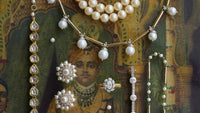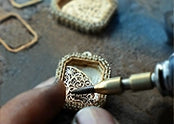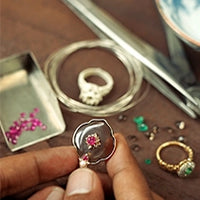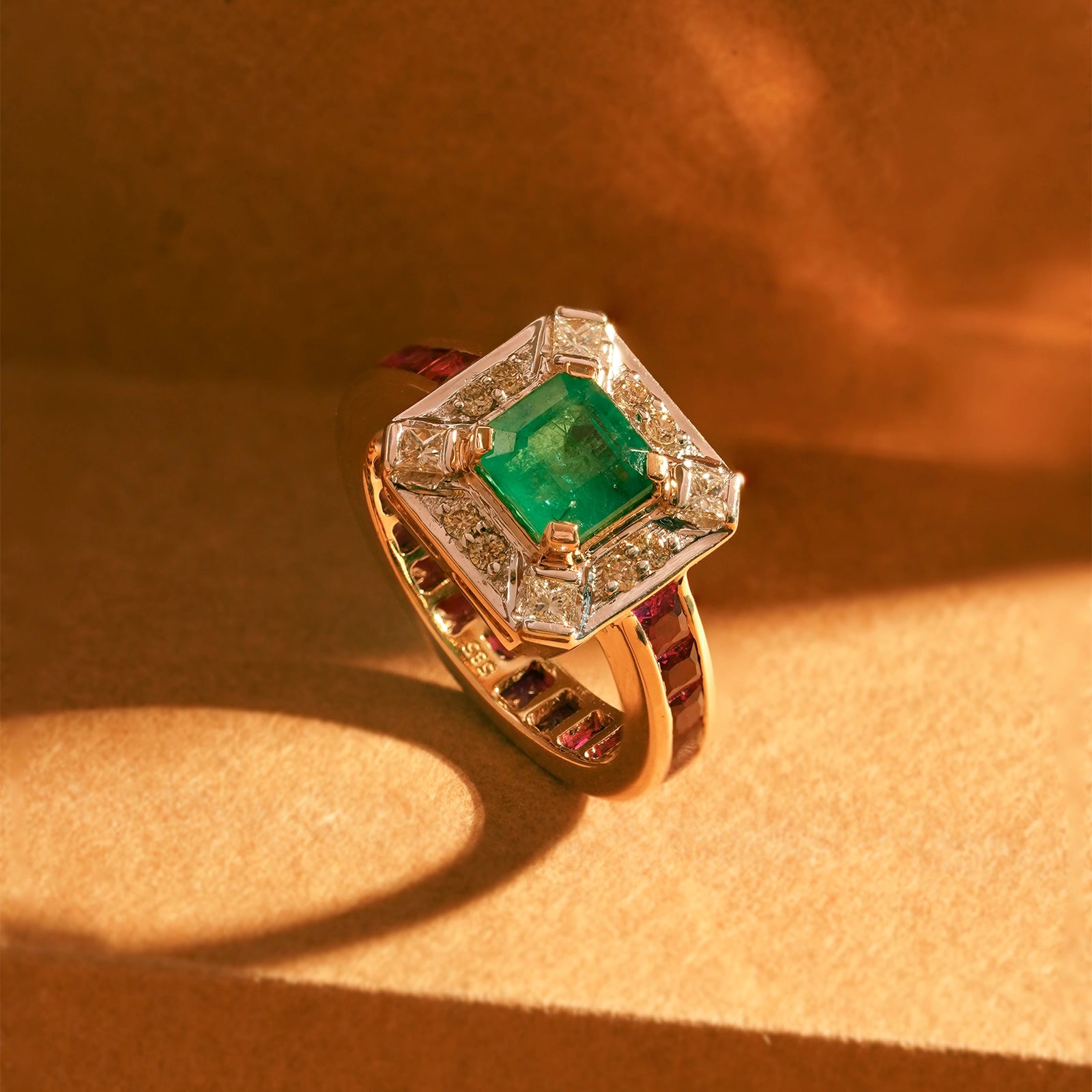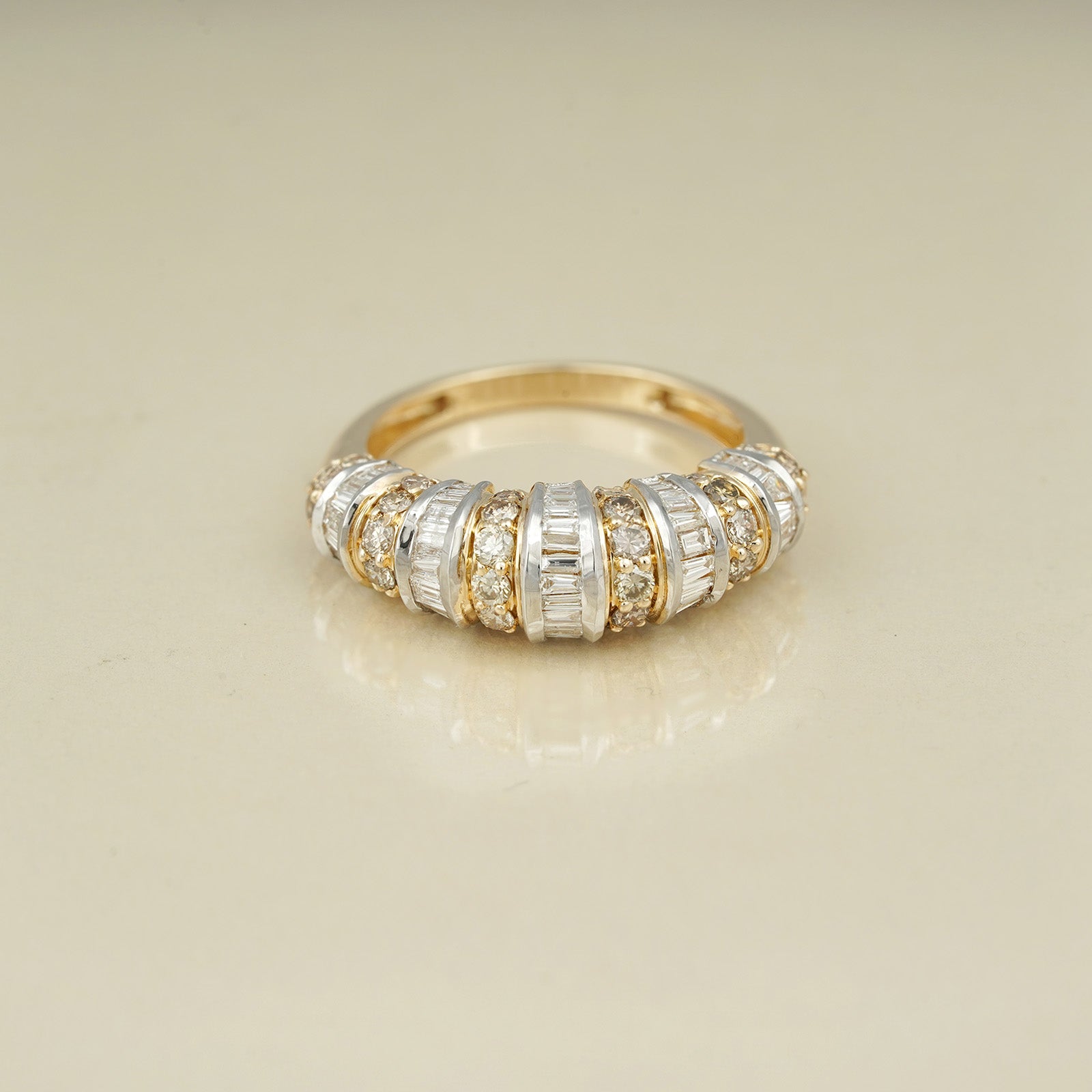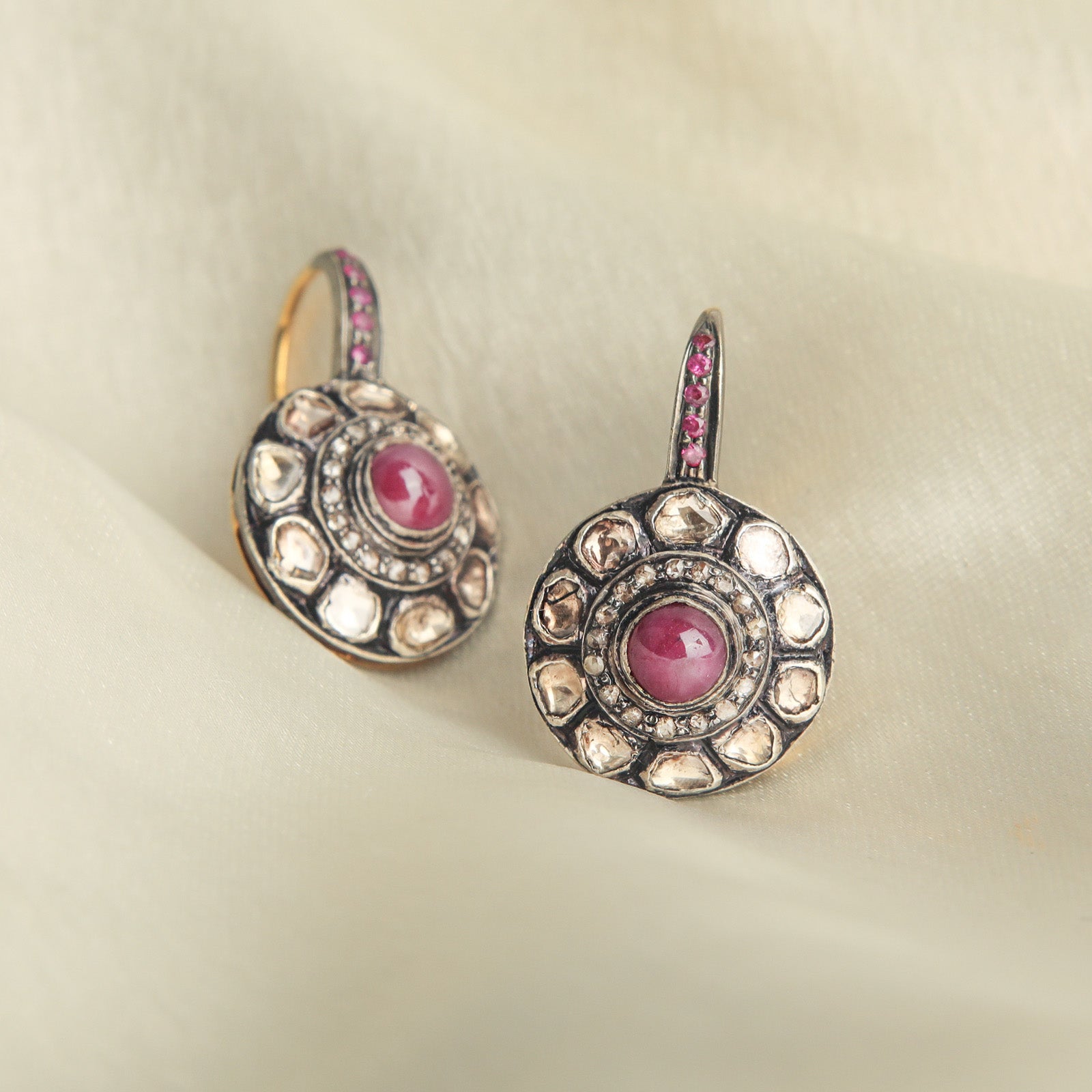'A ring is a halo on your finger.' - Douglas Coupland
Just as beautifully stated by the Canadian novelist and artist, nothing could be as pure as a round band on a finger. It is an honest truth that there is a ring for almost every moment in a person's life - be it as a gift to your loved one, an heirloom possession, or the promise of a bond for life. One of the most worn categories of jewelry, with ancient values and iconic appearances, there is so much we all ought to know about rings! Trust us, we’ll keep it fun!
(1. Nizam Ring, MOI. 2. Zaha Ring and Audrey Ring, MOI)
THE BEGINNING
The earliest rings belonged to the tombs of ancient Egypt. Primarily, signets or seal rings were used. A seal was engraved on the bezel and this ring could be used to authenticate documents by the wearer. Typically, the Egyptians would have the names and titles of the owners carved in hieroglyphic characters on oblong gold bezels.
(Ancient Egyptian gold ring, dated to the 26th dynasty (664–525 BCE). The ring belonged to Sienamun, a priest. Source: Metropolitan Museum of Art.)
Ancient Greeks would use rings as mere decorative items. During the Hellenistic period, the bezel began to be used in a way that it held cabochon stones - with the likes of carnelians and garnets, or even vitreous pastes.
Amidst the Romans, rings were a status of social hierarchy. Further revolutionising the concept of rings, the Roman civilisation is thought to have given birth to the customs of betrothal rings, or engagement rings - essentially symbolising a promise of marriage.
(Lot of 16 Roman gold rings, c. 1st century B.C.-3rd century A.D., set with emeralds, garnet, carnelian and jasper (some engraved), Source: Christies)
Traditional distinctions between the types of rings slightly disintegrated by the 19th Century - gracefully giving a way to rings inspired by the glorious past styles. This period witnessed the outbreak of industrialisation and paved a way for machine-made rings!
“The purpose of rings evolved to either adornment or as a symbol of marital fidelity.”
THE VARIOUS KINDS
While each ring was designed keeping in mind the occasion, the current times have seen a rather deflect from this behaviour. Through the progressing years, different types of rings have been worn for different kinds of beliefs - and of course, there are a lot of beliefs!
(Fire opal set in enamelled gold, Europe, belonging to 1750/1800. Source: Victoria and Albert Museum, London)
This ring forms part of a collection of 154 gems bequeathed to the V&A by the Reverend Chauncy Hare Townshend, a cleric and poet. Sir A. H. Church gave additional specimens in 1913. He also compiled the first catalogue Precious Stones: A Guide to the Townshend Collection. The first edition appeared in 1883. The stones are mounted as rings, although they may not have been intended to be worn. Some stones in the collection, including this Opal were acquired from the H.P. Hope collection, home of the famous Hope Diamond.
1. Bridal & Engagement Rings
The most popular category of rings, a symbol of love, a jewel that marks the precious moments of life, the beginning of a forever bond.Engagement and bridal rings have had historic mentions, stories from the famous and royal. And they gained cinematic attention like no other jewelry category. We can all agree to hearts melting to those incredibly perfect proposals on the silverscreen!
For centuries, wedding rings were the centrepiece of a marriage but they have been somewhat eclipsed by engagement rings. From Elizabeth Taylor’s iconic rock, Jacqueline Kennedy’s emerald by Van Cleef & Arpels, and Kate Middleton’s sapphire, reconfigured from Princess Diana’s engagement ring—all these pieces have bedazzled and overwhelmingly influenced brides’ expectations.
1.1 A Bridal Set
A bridal set consists of an engagement ring and a wedding band. Both of these are usually worn together in the left ring finger and complement each other.
(Bridal Set, Arabella, Source: Macys)
1.2. A Signet
“To start with, Prince Charles and Duchess of Cornwall don these!”

The ring, which is more than 175 years old, is the official signet of the Prince of Wales. Before Prince Charles, it was last worn by King Edward VIII when he was still Prince of Wales. Since his marriage to the Duchess of Cornwall, Prince Charles has added a wedding band to his little finger, in a stacked fashion. The Duchess of Cornwall also wears a signet ring on the little finger of her left hand to prove that it isn’t just what has been referred to as the ‘gentleman’s ring’.
Signet rings were used to authenticate important correspondence. Traditionally, a family crest is engraved in reverse on the bezel of the ring (although initials, letters and monograms are also popular). This allows one to wax signature seal correspondence with one’s family mark.
By dipping the signet ring into hot wax or soft clay, it leaves a distinct seal that was once considered to be more official than that of a signature.
1.3.Lover's Head
In Rome as they ventured the concept of personalising, they explored rings with the carvings of couples themselves. This type of a betrothal ring was a sign of the Byzantine Empire when most rings were carved with faces and full figures of the couples. Upon taking up Christianity as the official religion, these rings would often have a cross in between the couple - symbolising a blessed union.
(Gold marriage ring, Gold, 6th–7th century, Byzantine. Source: Met Museum of Art)
1.4. Claddagh Ring
The Claddagh ring belongs to a group of European finger rings called "fede rings". The name "fede" derives from the Italian phrase mani in fede, "hands joined in faith" or "hands joined in loyalty". These rings date back to the Roman times, when the gesture of clasped hands was a symbol of pledging vows, and they were used as engagement/wedding rings in medieval and Renaissance Europe. Having existed with many different styles for over a thousand years, they resurfaced in the 1100s and lasted for centuries. Over the years they became much more intricate with interlocking bands and ornate enamelling.
“Most commonly still worn today is the Irish Claddagh ring, two hands holding a heart with a crown. The Claddagh ring was first designed in the 16th century, thirteen centuries after the original fede rings of Rome.”
(Claddagh Ring in Gold, 16th century. Source: Met Museum of Art)
1.5. Gimmel Ring
Gimmel rings consist of 2-3 interlocking bands, wonderfully symbolic in that each band is free yet must remain together to create the whole. With early gimmel rings, the bride and groom would each wear a band leading up to the wedding day when they would be put together to symbolize the joining of two people. Many gimmel rings housed beautiful cut stones and ornate carved features highlighted with colorful enamel.
Later designs also included a touch of Memento Mori - featuring a skeleton and a baby, symbolizing life and death, and eternal love beyond this life.
(Renaissance Gimmel Ring W/Memento Mori, 17th Century, Germany. Source: Met Museum of Art)
1.6. Diamond Rings
While it is true that De Beers' popularized the concept of diamonds in an engagement ring, diamonds have indeed been used in love rings for several centuries before that. 100s AD Rome was the first instance of an uncut diamond ring - belonging to a young girl. However there is no way to know if it was a gift of love, a symbol of status or any other type of ring.
In the 15th century a gift of jewelry was often sent from the father of the bride to the father of the groom, proposing the intent to marry off his daughter. It was not uncommon for this gift to be a diamond ring, in a way, marking the beginning of the megatrend of diamond engagement rings.
The first documented diamond betrothal ring was in 1475 at the wedding of Costanzo Sforza and Camilla D'Aragona in Italy. Their wedding poem read “Two wills, two hearts, two passions are bonded in one marriage by a diamond”
(Illustration from Costanzo Sforza and Camilla D'Aragona's wedding depicting the diamond ring holding up the two burning torches.)
“The 19th Century saw the popularity of diamond engagement rings. They became a norm after the launch of De Beers' campaign "A Diamond is Forever" in the mid 1940s.
Today, a diamond engagement ring is still the first and favoured choice of many - however, alternatives are also on the rise with vintage designs, rough diamonds as well as non-traditional gemstones.
(1. Millenial Ring, 2. Twin Ring, 3. Nizam Ring, 4. Luna Ring, MOI)
1.7. Wedding Bands
A ring that is uniform in width, with no discernible “top”, the wedding band may be a simple gold band, can be engraved or set with gemstones.
(Marriage rings of D. Pedro I and D. Amélia de Leuchtenberg, 1828 - 1828, Source: Museu Imperial, Petropolis, Bazil. It was inherited by the Empress' sister, Queen Josefina, who gave a gift to the Baron Oscar Peyron, his chamberlain. Donated by the descendants of the Baron to the Royal Armoury in Stockholm, where he was discovered by D. Carlos Tasso of Saxe-Coburg and Bragança, a descendant of the brazilian imperial family.)
1.7.a Eternity Bands
An eternity band consists of a uniform width set with one or more continuous rows of identical gemstones or diamonds. The stones completely surround the band and are usually prong or channel set.
(Infinity Band, MOI)
(Emma Ring, MOI)
2. Cocktail Ring
"New Women" of the 1920s Jazz Age are known to bring these extravagant rings in vogue. Considered to be an ultimate accessory of 'excess', these women would flaunt cocktail rings at clandestine parties while sipping sumptuous cocktails, hence, these rings bore the name 'Cocktail'.
 Image:A Vogue cover from 1925 showing the iconic fashion and pearls
Image:A Vogue cover from 1925 showing the iconic fashion and pearls
In the 1920s, the most valuable cocktail rings showcased large diamonds or other precious gemstones such as emeralds and sapphires set in platinum or gold and surrounded by pave diamonds. More interesting designs used colorful gemstones such as opal, or novel and abstract shapes.
In this new era of burgeoning freedom, a bold cocktail ring was also a way for women to flaunt their independence. Usually worn on the right hand, the ring was blatantly not a wedding band and had most likely been bought with a woman's own money.
Nowadays, the possibilities for cocktail rings are limited in some ways due to the decreasing availability of large gemstones. But this can be solved by using other gems such as quartz, tourmaline, blue topaz or citrine.
(Turquoise Cluster Ring, 1800/1860, Italy. Source: Victoria and Albert Museum, London)
(Audrey Pearl Ring, MOI)
(Pearl and Diamond Ring: It was probably made between 1910-1920 and has the streamlined geometric look that started in the late Edwardian era and continued into the Art Deco period. Source: Smithsonian Institution)
(Slate Ring, Mojito Ring and Jaipur Ring, MOI)
3. Contemporary Rings
Contemporary rings is one term to talk about the rings which are modern and mostly trend-based. What truly makes a ring contemporary is its cut, the setting, design, the way it is worn or maybe even the choice of the materials. In terms of design, a contemporary ring is more clean and minimalistic than an extravagant, flashy characteristic.
(1. Contemporary Wedding Band - Twin Ring, 2. Contemporary Band - Matte Ring, 3 and 4. Contemporary Stone-cuts - Hexa Ring and Taj Ring, 5.Contemporary Design - Paris Ring, MOI)
A fair amount of contemporary also comes from the fingers that you chose to wear the rings on! While stacking is the latest trend that has taken the ring industry by a storm, changing the placement of rings to more unconventional locations on the hand has become popular too.
Here are a few instances to prove the statement.
(Stack of Chunky Rings, Mejuri)
(Stack of Contemporary Rings, MOI)
4. Birthstone Ring
A birthstone ring is one such belief that focuses on certain qualities in precious or semi-precious gemstones that have proved to be beneficial to a wearer according to their birth months. It is a perfect personalized gift with a positive connotation.
(Garnet for January, Birthstone Ring, Mociun)
GEMSTONES ARE IMPORTANT!
Diamonds have always symbolized true love, but what are the symbolic meanings of other popular gemstones that are now used for engagement rings as well? From ancient times to today, gems of every hue have been imbued with significance and special powers by cultures around the world.
While stones like Agate are known for their protective qualities and balance of energies, Amethysts calm down emotions and encourage a clarity of thought. As Blue topaz is a stone that associates with the quality of courage, overcoming fears and promotes fidelity, citrine is known to encourage new thoughts and balance impatience.
(Agate, Amethyst, Blue Topaz, Citrine)
Emerald is a traditional stone, and it is stated that emerald aids fertility, improves eyesight and gives the wearer psychic powers. Similarly, pink rose quartz is known as the stone of "gentle love", rose quartz brings peace and calm to relationships. Red ruby is famous as a protector from misfortune and bad health, ruby is also used to open the heart and promote love.
(Emerald, Rose Quartz, Ruby)
Sapphire has long associations with peace and happiness, and is believed to help with communication, insight, intuition, inspiration and prayer. The ancients believed that sapphires could help them to predict the future. Violet-blue tanzanite is a recently discovered gemstone, said to be connected with the traditions of the Masai tribe, who believe that it has healing properties. Tourmaline is said to strengthen both body and spirit. It is believed to attract inspiration, aid concentration, encourage balance and promote understanding.
(Sapphire, Tanzanite, Tourmaline)
WHICH FINGER AND WHAT RING ?
Often, inferences about personality and relationship status are made depending upon the finger you wear you ring on. These assumptions are based on beliefs that have been passed down through history and cultural backgrounds. Before putting on a ring, it could be helpful to know which finger signifies what!
The ancient Egyptians believed in the vena amoris, literally the “vein of love” that runs directly from the heart to the fourth finger on the left hand. Since then, wedding rings have been worn as a sign of the
binding pledge between spouses. The endless circle shows the eternal nature of the union, with the open centre a portal to the unexplored life ahead as a couple. This sentimental theory is recognized in western cultures and is the main reason the engagement and wedding rings are worn on the fourth finger, now referred to as the “ring finger”. In other cultures, however, the ring is worn on the right hand, since that is the hand used for oaths and vows.
- The ‘pinky’ or ‘index’ finger
The little ‘pinky’ finger and the first ‘index’ finger have become fashion statements only in recent years. People choose to wear rings on these fingers to bring added attention to the hand. They can be quite daring as they really do make a statement, but they can look amazing! It’s a way to say “Hey, look at all these fashionable rings!"
The middle finger is the most popular finger of all for rings. This finger became popular for rings in order to avoid the ring finger confusion. This being the case, the middle finger was a safe default. Due to its location on the hand, rings on this finger show a sense of balance and responsibility. Rings on this finger add glamour and class to an outfit. It gives it an extra sense of style without being too forceful. Often, people chose to wear cocktail rings on middle fingers for a more voluminous, yet balanced look.
While concluding this vast topic of rings, it is safe to say that there is much more about rings that still remains untouched! Right from the birth of rings during the Egyptian Civilisation to up until now, rings still remain the most pure and perfect form of love towards any person - be it as a priced ancestral possession handed down to you, or a glorious engagement ring to pursue your better half - the list of nostalgic moments is endless! And surely, there is one ring to hold on to for every one of those instances!
-




























